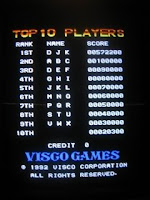I was lucky to buy Ketsui back in early 2005 while the hype (and monetary value) was still at a relative low point. Since then, the game had grown into legend with the failed Arika PS2 port and superplay debacle, failed Mame dump attempt, soaring PCB prices, and DS mini-game version giving only a glimpse of this classic Cave style play.
With the recently released 5pb port of the game on Xbox 360, now those who typically trolled the forums with angst towards PCB owners are finally getting their own taste of the game, and realizing it may have been worth the hype as one of Cave's top produced games this decade.

So how does the port stack up against the PCB? Lets find out.
At a recent Bay Area shmupmeet, a side-by-side comparison was setup for participants to judge for themselves. In an attempt to level the playing field, two identical arcade cabinets were used with sanwa arcade controls and tri-sync arcade monitors. The original PCB runs natively at 15khz video resolution, while the XB360's lowest setting 640x480 resolution was used. Obvious differences in the graphical look were apparent, but most participants didn't much mind the XB360 scaled graphics, which were helped by various filters used to reduce the blockiness. A noticable lack of formal HD graphics, and no scanline display options in the 5pb port pailed in comparison to the previous two Cave ports (Mushihemesama Futari, and Espgaluda II). Its arguable that external scaling hardware could be used to restore a 15khz display with native scanlines, although this would not be considered "pixel perfect" by purists. The only Cave ports that have "pixel perfect" bestowed upon them are Arika's PS2 Espgaluda and PS2 DoDonPachi Dai-Ou-Jou, which both run at a native 15khz (non-interlaced).

From this distance, both PCB and port look identical (despite a slight color variation in the monitors), but the game speed was noticeably different.
The next noticeable difference when playing the port was the game speed, which felt slightly faster than the original PCB. Again another compromise when porting a low resolution arcade game to a modern console that displays on consumer LCD screens and television sets. Does this really effect the playability of the port? Certainly not. But rest assured, console players will be quick to point out that they are playing at a slight disadvantage to the PCB.
Lastly, the sound, which normally a port should exceed the PCB, given it can play in stereo and with newly arranged soundtracks, but unfortunately the port being based on the last Ketsui rom fix, includes the slightly louder lock-on sound, which can be quite annoying if you are used to the original PCB rom. Of course with the fixed roms comes no chance of the game crashing during the demo sequence, which I've never personally witnessed on my PCB since I don't use freeplay settings.

So what makes the port better than the PCB?
Being an order of magnitude cheaper than the cost of the PCB is certainly a bonus, but the port has many advantages over the PCB which can't be denied. First and foremost is an all new arrange mode, which takes bullet canceling in Ketsui to a new level. I haven't spent much time with this mode yet, but it certainly looks fun, despite it not being created by IKD/Cave.
Next on my list would have to be the ability to practice individual levels, without which progress for me on the PCB has been quite slow. Being able to practice Stage 4 and 5 the past two days has been a great time saver, not to mention much more pleasurable without making those minor mistakes in the first 3 stages which prevent you from having a high scoring run. Something lacking, is the ability to practice individual bosses, which seems odd given this has been a standard in almost every other Cave port to date.
Last are typical XB360 port features such as arrange soundtrack, online leaderboards with downloadable replays, gamer icons, and wallpapers, all which don't interest me much to be honest. The replays are a nice tool to help see how others approach the game, but there have been plenty of Ketsui superplays/DVDs available before now, its really only worth watching if someone exceeds these previous records.
In Summary, the port is definitely worth owning, and all who played it at the shmupmeet thought it was faithful to the PCB (ignoring the slight speed difference). Unfortunately, 5pb's effort pales in comparison to previous Cave ports in terms of features, modes, and settings. This may be due to the high amount of pressure to release the game on time, and bug free, unlike their failed Dai-Ou-Jou 360 attempt. The question now remains if the port sufficiently bursts the hype bubble around the PCB to deflate its value to any significant degree. Given the largely positive feedback I've read on the forums, I think this may take longer than expected due to a now wider acknowledgment that Ketsui is indeed one of Cave's finest.



























































